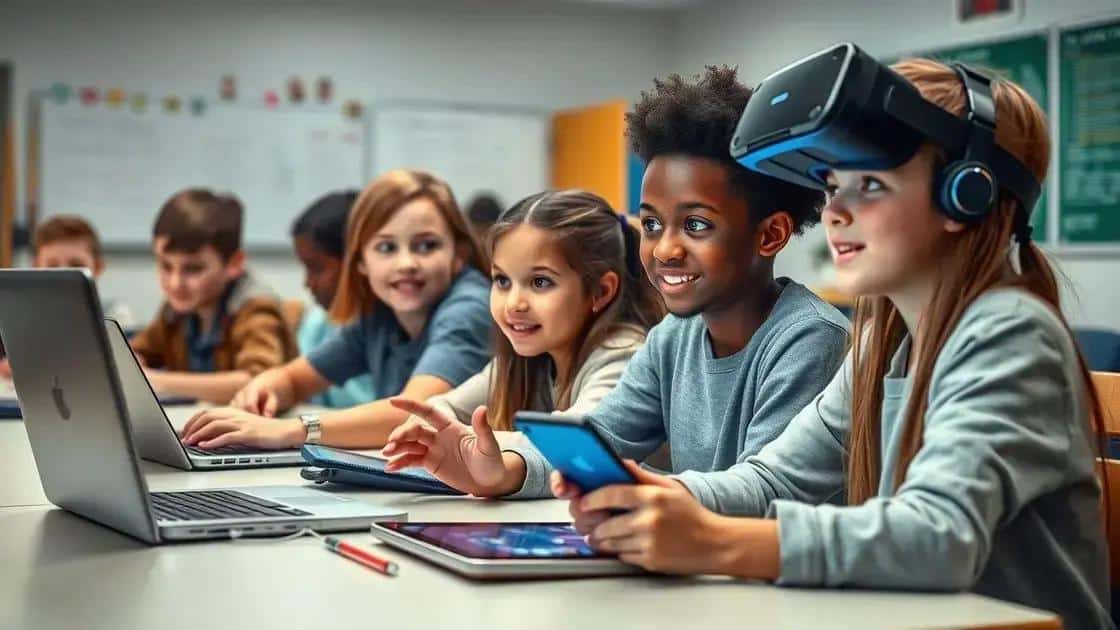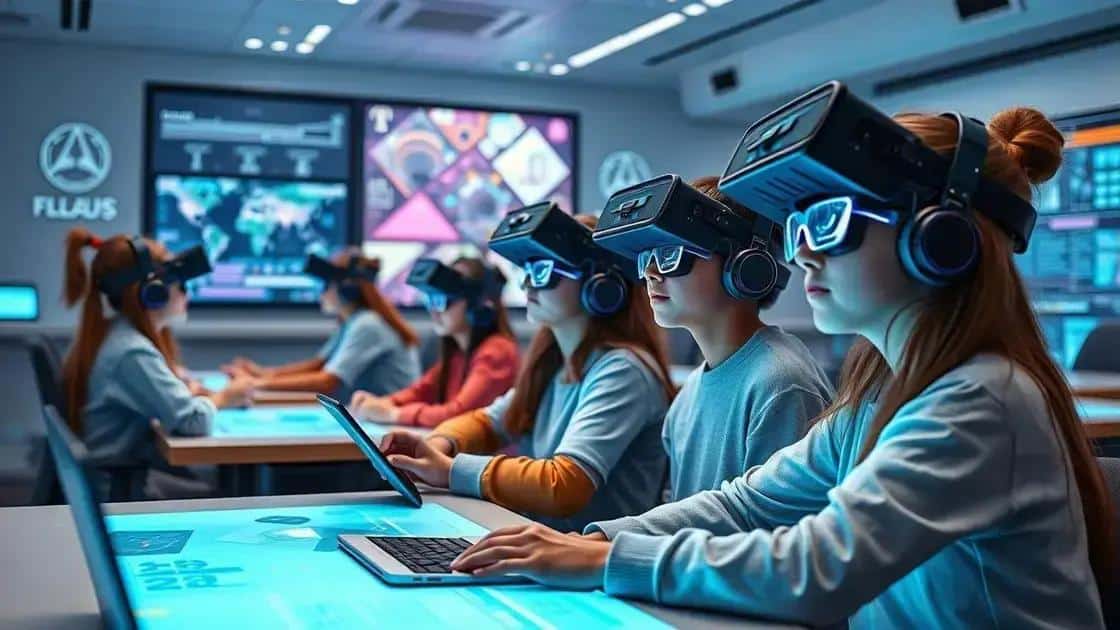AI in classrooms trends: what to expect

AI in classrooms trends are reshaping education through personalized learning experiences, innovative technologies like virtual reality, and increased student engagement, while also presenting challenges such as funding and teacher training.
AI in classrooms trends are reshaping education as we know it. Imagine walking into a class where technology personalizes learning just for you. Curious about how this unfolds? Let’s dive into some exciting possibilities.
Emerging technologies in classroom AI
Emerging technologies in classroom AI are opening up new possibilities for education. These innovations are not just reshaping the way teachers instruct, but also how students learn and engage with content.
One important aspect of these technologies is their ability to personalize learning experiences. AI tools can analyze how students learn and adapt the curriculum to meet individual needs, ensuring that each student gets the support they require.
Key technologies impacting classrooms
Several technologies are driving the AI revolution in education:
- Adaptive learning platforms: These platforms adjust the difficulty of content based on student performance.
- Artificial Intelligence tutors: Virtual tutors provide additional help to students outside of regular classroom hours.
- Data analytics tools: These tools help teachers understand student progress and tailor their teaching strategies accordingly.
- Natural language processing: This technology enables machines to understand and respond to student inquiries in a conversational manner.
As educational institutions continue to adopt these technologies, the classroom experience is evolving dramatically. Imagine a classroom where every student interacts with AI that not only understands their unique learning style but also actively engages with them in real-time.
The integration of AI can significantly enhance student engagement. For instance, interactive learning experiences powered by AI can motivate students to explore topics more deeply. When students find lessons engaging, they are likely to retain information better and develop a passion for learning.
Future trends to watch
As we look to the future, several trends are becoming prominent:
- Increased use of VR and AR: These technologies will offer immersive learning experiences, allowing students to explore subjects in a lifelike context.
- AI-driven assessments: This approach will streamline grading and help identify areas where students struggle.
- Collaborative learning through AI: Students will work together with AI systems to solve problems, enhancing teamwork skills.
Incorporating emerging technologies into classrooms holds great potential. Teachers can leverage these tools to create more interactive and personalized learning environments. As the education sector continues to embrace AI, it’s exciting to think about how these advancements will further transform our classrooms.
Enhancing student engagement with AI

Enhancing student engagement with AI is revolutionizing how education is delivered. The goal is to create a learning environment where every student feels involved and motivated. With technology growing rapidly, it’s important to explore how these new tools can make learning more relevant and exciting.
One effective method is through interactive learning. AI programs can offer personalized feedback in real-time, making lessons more accessible and engaging. This allows students to participate actively rather than passively absorbing information.
Interactive tools and their benefits
Here are some interactive tools powered by AI that are transforming classroom dynamics:
- Gamified learning: This approach turns lessons into games, encouraging students to complete challenges and earn rewards.
- Virtual reality experiences: VR can immerse students in historical events or scientific explorations, creating memorable learning moments.
- Chatbots: These can provide instant answers to students’ queries, helping them feel supported even outside classroom hours.
- Collaborative platforms: Tools that allow students to work together on projects easily boost engagement and develop teamwork skills.
Moreover, AI can track student progress and identify areas needing improvement. By analyzing data, teachers can tailor their instruction methods to keep students on track. For instance, if a student struggles with math concepts, AI systems can suggest targeted resources to help them improve.
Another significant benefit of using AI in classrooms is the ability to foster creativity. With AI tools, students can explore subjects in new ways. They can create multimedia projects, design simulations, and even experiment with coding without extensive prior knowledge. This kind of freedom can ignite a passion for learning.
Real-world applications of AI
AI is already being implemented in various educational settings. Some schools have introduced personalized learning platforms that adapt based on student performance. This level of customization helps to maintain student interest and ensures that they are always challenged appropriately.
- Predictive analytics: By using data, institutions can forecast student performance and intervene early if someone is at risk of falling behind.
- Enhanced feedback systems: AI can analyze student submissions and provide instant feedback, facilitating quicker learning and adjustments.
- Language learning apps: These tools utilize AI to adjust lessons based on a learner’s progress and preferences.
As classrooms evolve with the help of AI, the focus will continue to be on enhancing student engagement. With the right tools, learners can thrive in an environment that values their input and adapts to their needs.
Challenges faced in AI adoption
Challenges faced in AI adoption within classrooms are significant and varied. While the potential for enhancing education is vast, numerous barriers must be addressed to ensure that AI can be effectively integrated into learning environments.
One notable challenge is the lack of adequate training for teachers. Many educators feel unprepared to implement AI tools effectively. Without proper guidance and professional development, teachers may struggle to utilize new technologies and miss out on their benefits.
Common barriers to AI adoption
Here are some common barriers that schools face:
- Funding: Implementing AI solutions can be expensive. Many schools operate under tight budgets, making it difficult to invest in technology.
- Infrastructure: Schools may not have the necessary hardware and software to support AI applications.
- Resistance to change: Some educators may be skeptical about AI and prefer traditional teaching methods instead.
- Data privacy concerns: Schools must ensure that student data is protected when using AI technologies.
Moreover, adapting the curriculum to incorporate AI requires careful planning. Creating lessons that align with technological tools can be challenging. Schools must find a balance between teaching fundamental concepts and integrating advanced technologies.
Another difficulty is keeping pace with rapid advancements in AI. As technology evolves quickly, educators must continuously learn and adapt. This can be overwhelming, especially for those who are not tech-savvy. Additionally, maintaining student engagement with these tools can be a challenge too. Not all students may respond positively to AI interactions, making it essential to monitor their progress and adjust teaching methods accordingly.
Strategies for overcoming challenges
To navigate these challenges, schools can implement several strategies:
- Invest in teacher training: Providing ongoing professional development helps teachers gain confidence and skills.
- Secure funding through grants: Schools can seek grants and partnerships that support AI initiatives.
- Foster a culture of innovation: Encouraging educators to experiment with AI can lead to more widespread acceptance.
- Enhance data protection measures: Schools should prioritize student data security when implementing new technologies.
As institutions begin to address these challenges, they can better position themselves to leverage the benefits of AI in education. Embracing these changes will ultimately enhance the learning experience for students and prepare them for a technology-driven future.
Future predictions for AI in education

Future predictions for AI in education are exciting and transformative. As technology advances, the way students learn and interact in classrooms will change dramatically. Educators are eager to see how AI will shape curriculum and teaching methods next.
One major prediction is the rise of fully personalized learning experiences. With AI, every student can receive lessons tailored to their unique learning styles and paces. Imagine a classroom where each lesson is customized just for you!
Emerging trends to watch
Here are some trends that may define the future of AI in education:
- AI-driven learning platforms: These platforms will analyze student data to adapt lessons in real-time, creating more effective learning environments.
- Greater use of virtual reality: VR will allow students to immerse themselves in educational experiences, making learning more engaging and interactive.
- Collaborative learning through AI: Students will work together with intelligent systems, enhancing peer-to-peer interaction and problem-solving skills.
- Continuous assessment tools: AI will provide ongoing feedback to both teachers and students about progress, making learning more targeted and efficient.
Furthermore, as AI tools become more accessible, schools of all sizes will likely implement these technologies. This means that even in underserved areas, students can benefit from high-quality resources and learning experiences. The gap between different educational institutions may begin to close.
Teachers will also play a crucial role in the integration of AI. As facilitators of learning, they will guide students in utilizing these technologies effectively. This collaboration may lead to a evolved teaching model where educators focus more on mentoring and less on lecturing.
Preparing for the changes
As institutions prepare for these shifts, training and support will be essential. Professional development programs focused on integrating AI into the classroom will help educators feel more confident. Schools should prioritize these initiatives to ensure that teachers can embrace the future of education.
- Investment in technology: Ensuring that schools have the necessary tools and infrastructure to support AI solutions is key.
- Collaboration with tech companies: Partnerships with technology providers can help schools stay updated on the latest innovations.
- Incorporating ethics into AI education: Teaching students about the ethics of AI will be crucial as they navigate a technology-rich future.
Overall, the future of AI in education holds great promise. By embracing these innovations and preparing for change, educators can create dynamic learning environments that cater to the needs of all students.
In conclusion, the integration of AI into education brings both opportunities and challenges. As classrooms evolve, embracing AI can lead to personalized learning experiences that cater to individual student needs. While the future looks bright with innovations like virtual reality and adaptive learning tools, it is essential to prepare educators and invest in technology. By addressing the challenges ahead, we can create enriching environments that inspire both students and teachers. AI is not just a trend; it’s a catalyst for change in the educational landscape.
FAQ – Frequently Asked Questions about AI in Education
How can AI personalize learning experiences for students?
AI can analyze individual student progress and adapt lessons in real-time, ensuring each student learns at their own pace.
What are some challenges schools face in adopting AI technologies?
Schools often struggle with funding, training for teachers, and data privacy concerns when implementing AI solutions.
How can teachers benefit from using AI in their classrooms?
AI can help teachers save time on grading and administrative tasks, allowing them to focus more on personalized student interaction.
What future trends should we expect in AI education?
We can expect more interactive learning tools, adaptive learning platforms, and increased collaboration between students and AI systems.





